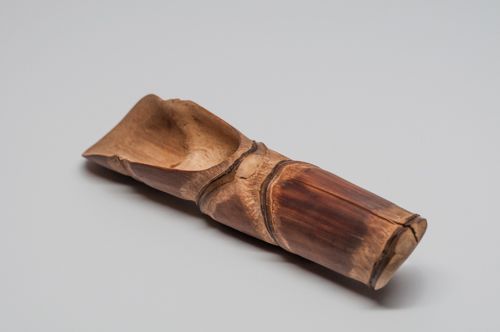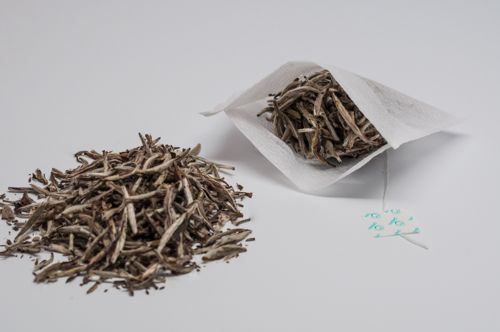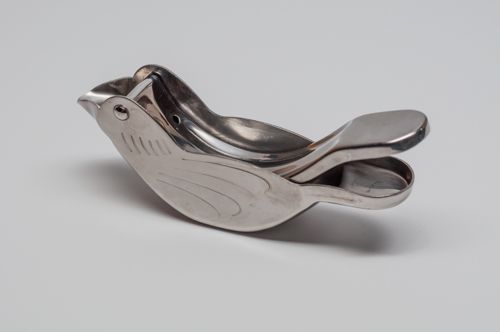Tools for Making Tea
If you're new to brewing loose leaf tea, there are a few tea accessories that will make the brewing process more consistent, convenient, and elegant. This page describes three accessories that are inexpensive and practical to have on hand for making tea.
Follow these links if you're looking for specific information about infusers and strainers, teapots, or brewing tea.
Tea Scoops
Have you ever tried picking up whole leaf tea with an everyday teaspoon? Unless the tea leaves are very fine, they will fall off the spoon, or you won’t be able to pick up enough of them to be practical. Back in the day, I just used my fingers to pick up the leaves and guesstimated how much tea I was putting into the pot. Not very scientific (or hygienic), but it worked well enough.
Then one day during my first trip to Hong Kong, I visited a tea shop and bought my first Chinese teapot. Sitting beside the check-out counter was a barrel of bamboo scoops. At the time I just thought they looked cool, so I picked one up. The shopkeeper saw my interest and demonstrated how useful they were for scooping up tea leaves, and also how you can measure amounts (more or less) by using the marks of the bamboo. I fell in love…with the bamboo tea scoop.

That was eleven years ago and I still use that same bamboo scoop. I love the feel of it in my hand. It’s warm and lightweight. I can feel the weight of the tea leaves when scooping them, and then eyeball the right amount just by looking at how many tea leaves are on the scoop. There are other tea scoops out there, but I have found “the one” for me.
Tea scoops help you to be consistent about measuring the right amount of tea. Using the same scoop each time you're making tea helps take the guesswork out of how many tea leaves to use. Even if it doesn't have discernible marks on it like my bamboo scoop, you will still be more consistent about measuring your tea when you use it than when you don't. Check for this product if you have an Asian grocery store in your city. That's where my sister found one for $1.99. It's one small investment we both highly recommend.
DIY Teabags for Making Tea
Pre-packaged teabags are more expensive than buying loose tea, but what if you like the convenience of a teabag AND the quality of loose leaf tea? These days you can buy a packet of empty teabags and fill them with whatever loose leaf tea you choose—so you do it yourself. It’s quite wonderful.
For about $5 you can buy 100 empty teabag pouches, so it's also very inexpensive. Once you've added the appropriate amount of tea, fold the flap over to "seal" it (or use a drawstring, depending on the brand), and plunk it into your cup or pot. If you're looking for these online, they are usually called paper/disposable tea filters or brewing bags.

Making your own teabags is very convenient when you’re on the go. Maybe you have a long commute and want to take your morning tea along with you. Use your tea scoop to fill the bag. Just make sure to hold the empty pouch open as wide as possible, drop in a scoop of leaves, close the bag (using the flap or drawstring), and then use it just like any other teabag.
Both paper and silicone teabags are available. The paper teabags can hold more tea and work in either a cup or pot. If you’re using whole leaf tea, you can still do multiple brews with the same teabag.
The silicone bags we've seen are intended for a single serving. The advantage of the silicone teabag is that it's reusable and will last an indefinite period of time. Unfortunately, in our opinion, it suffers from the same disadvantage as small teaballs (see Infusers and Strainers); that is, there isn't much room for the leaves to expand, and so you may not get the most flavorful brew when making tea with them.
Teabag Squeezers
When I was living in Belgium I bought a little stainless steel device I thought was a lemon squeezer. Unfortunately, it did a really poor job of squeezing lemons. But I liked its little bird design and kept it, hoping to find a better use for it. Seven years later I was visiting my sister-in-law in New Zealand, and I learned that my little bird was actually a teabag squeezer! (If I had been able to read French or Flemish I would have known this much earlier.) In any event, I'm glad I didn't throw away my teabag squeezer.

Since that time, my sister told me about a little pair of flat-ended tongs she bought that accomplishes the same task—squeezing a teabag. Originally she thought her teabag squeezer purchase was silly. But it was a “vacation purchase” and we’re all allowed to bring home silly things from our vacations—that’s what make memories, right? What she found was that it does a much better job than an ordinary teaspoon, and she hasn’t split open a wet teabag ever since she has used the tongs, something that happened with some frequency when using a teaspoon for the same purpose.
I'm sure you're wondering why you can't just use a teaspoon for squeezing the excess liquid from a teabag. Well, you can and plenty of people do. Some folks are quite adept at using a spoon, especially if they grew up in a tea-drinking household. But if you're like us and a spoon just doesn't quite do the job, get a teabag squeezer or a pair of tongs made for this purpose, and make your life easier.
A Few Final Words about Basic Tools
for Making Tea
The purpose of this page was to describe a few of the most basic and common accessories for making tea. You don’t need them all, and maybe you don’t need any of them. But if your tea brewing experience is a little rough around the edges, these tea accessories could elevate it to the next level.
All of these tea accessories are inexpensive. So jump in, buy what you think might work, and try it out. Have fun and experiment. The worst that will happen is you’ll re-purpose the accessory if it doesn't suit your tea brewing needs.